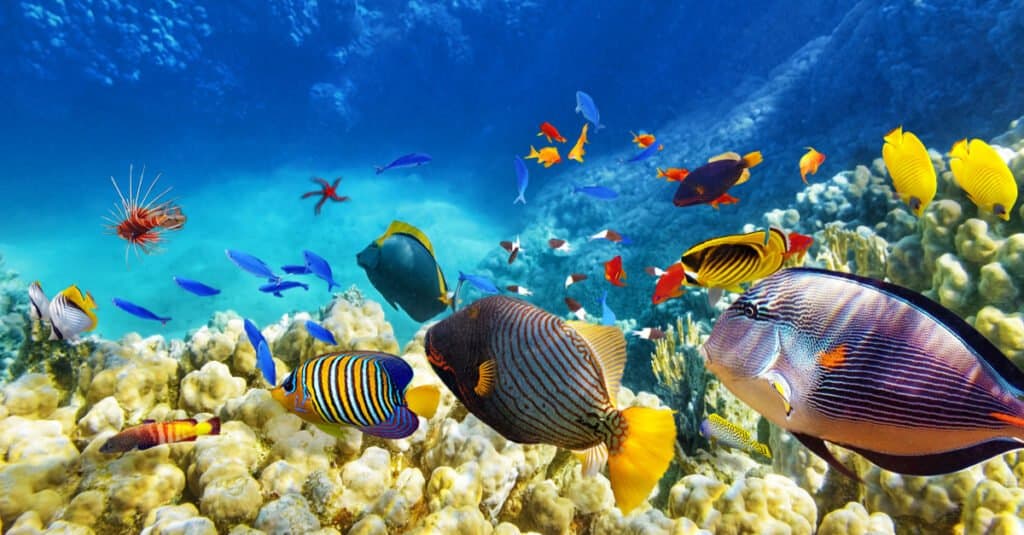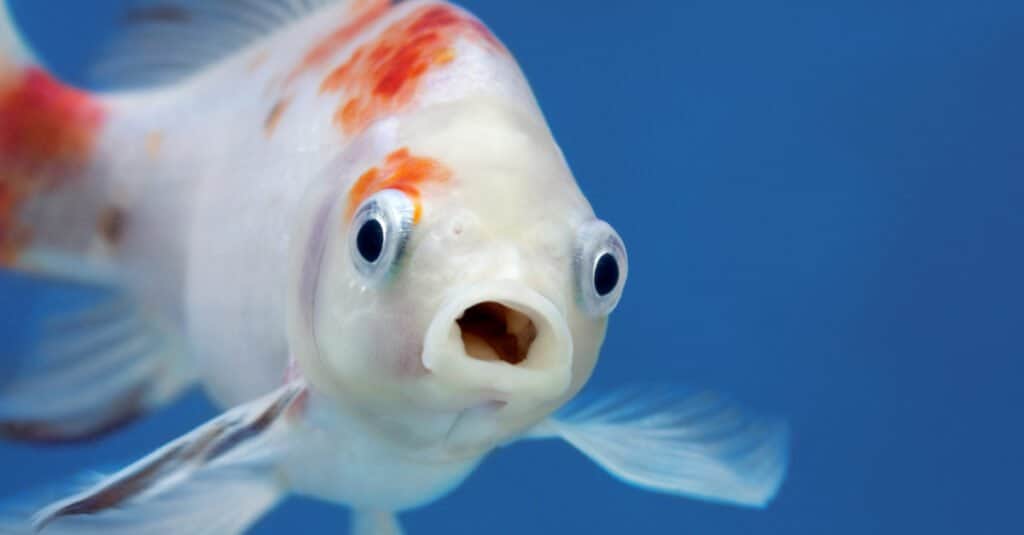Are fish mammals? Fish are not mammals, but they are such a diverse group that putting all of them in one class is inefficient. They used to be grouped in the class Pisces, but now they are classified into three classes and a multitude of subclasses, clades, orders, suborders, tribes, superfamilies, families, genera, and species.
Is a fish an animal? Actually, a fish is a member of the most diverse group of vertebrates, or animals with backbones, on Earth even though at least one, the ghastly hagfish, doesn’t really have a proper backbone.
They come in forms as different as the mola, the great white shark, the shockingly beautiful mandarin dragonet, the long-horned cowfish, and the tiny guppy. Some belong in clades that contain animals that are not fish at all. However, whatever biologists know about fish, they know that they’re not mammals.

©V_E/Shutterstock.com
Why Are Fish Not Mammals?
Fish are not mammals because most of them are not warm-blooded, though some sharks and species of tuna are exceptions. They do not have limbs, fingers, toes, fur, or hair.
Most of them can’t breathe air because they don’t have lungs, though the lungfish and the snakehead are also exceptions. The great majority have gills that let them extract oxygen from water. They can only survive in the water.
They lay eggs or give live birth, but no fish nurses it’s young with milk, an action that separates mammals from every other type of animal. Even pigeons who feed their young with crop milk or tsetse flies who feed their young with something like milk in utero don’t count as mammals.
Why Do People Think Fish Are Mammals?
People may think of fish as mammals because not very long ago scientists believed that many mammals were fish. These mammals spent most or all of their lives in water and included whales, seals, sea lions, and even the hippopotamus. These animals are mammals, but they are not fish. Even whales, dolphins, and porpoises (animals that look very much like fish) are warm-blooded and feed their babies with milk. Even though they can hold their breath for very long periods of time underwater, they still need to breathe air.
Many species of fish also care for their young with the devotion usually associated with mammals. Male jawfish, bettas and arowana incubate eggs in their mouth, which is called mouthbrooding. They, of course, can’t eat while they hold the eggs. Seahorse fathers famously gestate their babies then give birth. Other fish brood their young in their skin or their gills, and some babies first eat the mucus from their parents’ skin. Some cichlids protect their young by warning them of danger through movements, while others protect their young even after they’ve become sexually mature. They are still not mammals.

©Noheaphotos/Shutterstock.com
What kinds of fish are there?
Scientists have divided these animals into three classes. There are actually more than three, but the other classes are extinct. The three extant classes are:
- Agnatha: These are jawless fish, which are the lampreys and the hagfish.
- Chondrichthyes: These are the fish whose skeletons are made of cartilage instead of bone. These are the sharks and the rays. By the way, all mammals have skeletons made mostly of bone.
- Osteichthyes: These are fish whose skeletons are made of bone. They include those with fleshy fins like coelacanths and lungfish and those with rayed fins, which is just about every other fish that isn’t in the two other classes.
Is a Fish an Animal?
Fish can be lumped together with mammals such as whales, dolphins, and sea lions under the term “sea animals.” But as we’ve already discussed, mammals and fish don’t share the same characteristics. However, they do share this–they are both vertebrates. Fish, as well as mammals, have backbones, or spines.
But is a fish an animal? Any living thing that has a backbone, is capable of movement, and must find and digest food is classified as an animal. So yes, a fish is an animal.
Up Next…
Here, fishy fishy! Enjoy fore fish facts!
- 10 Incredible Fish Facts These facts might make you think twice about eating a fish. They are quite intelligent and amazing!
- 10 Incredible Flying Fish Facts As if the fact they can “fly” wasn’t enough, check out more fascinating flying fish facts!
- Pet Fish Want an aquarium in your home? Read about which fish make the best pets.
The photo featured at the top of this post is © iStock.com/beronb
FAQs (Frequently Asked Questions)
Which fish are endangered?
Unfortunately, too many species are endangered. Fish seem especially vulnerable to extinction through overfishing, habitat destruction, pollution, and global warming that heats up the waters where they live. Warm water holds less oxygen than cold water, and the oceans, lakes, and rivers are seeing more and more dead zones. Fish are endangered whether they’re found in the polar regions, the tropics, and subtropics, in freshwater, saltwater, or brackish water. Some that are endangered include:
• Southern bluefin tuna. This tuna is found in the waters of the southern hemisphere and is critically endangered.
• Crystal darter. This little creature is found in fast streams in the basins of the Mississippi and Ohio Rivers, though it’s been extirpated from much of the Ohio River area. It is considered vulnerable.
• Atlantic cod. The Atlantic cod was fished nearly to extinction in the 1990s and has still not really recovered. It is listed as vulnerable.
• Beluga sturgeon. This ancient and long-lived creature has been hunted and poached for its roe to the point where it is now critically endangered.
• Zebra shark. This shark, found in the coral reefs of the Indo-Pacific area, is endangered due to habitat loss and hunting for its fins, its liver, and its meat.
How many species of fish are there?
There are many more species of fish than there are mammals. There are about 33,000 species of fish compared to 6400 types of mammals.
Are fish omnivores, herbivores or carnivores?
They can be all three! Herbivorous fish include parrotfish, some types of butterflyfish, surgeonfish, some species of blennies, and damselfish. Because they eat plants, these animals are found in shallow water where the sunlight can penetrate and allow plants to photosynthesize. They eat seaweed such as glassweed, latok, Halimeda, and Sargassum. They also eat corals such as Turbinaria. Of course, corals aren’t technically plants, but the fish don’t know this. Mullets eat small aquatic animals when they are young and turn to seaweed when they’re mature.
Just about every freshwater fish is an omnivore, which means they’ll take plant and animal material, which includes algae, aquatic life that they can handle, parasites found on other fish, insects, and eggs. Bonnethead sharks are also omnivorous, and they’re the only sharks known to be so. Fish that are truly carnivorous such as tuna and sharks besides the bonnethead may accidentally ingest a plant, but a plant is useless to them, nutrition-wise. They evolved to eat and benefit from meat.
Are fish dangerous?
While most are not dangerous to people, there are a number of species that are supremely dangerous. Chief among these is the great white shark, which is responsible for more fatal shark attacks than any other shark. Humans are not normally the shark’s prey, but in the ocean, they may resemble seals, which are. The shark may take an exploratory bite out of a swimmer but that is all it takes to cause a serious or even fatal injury. Bull, tiger, hammerhead, and mako sharks have also been known to attack humans.
Other fish are dangerous because they are venomous. This includes the beautiful lionfish, the stonefish, the striped eel catfish, and the stingray. Some have sharp spines that, while nonvenomous, can cause puncture wounds. These creatures include the triggerfish, surgeonfish, and types of catfish besides the striped eel. Others are poisonous to eat, such as certain species of pufferfish or fish that are contaminated with mercury or ciguatoxin. Ciguatoxic fish aren’t naturally poisonous but pick up toxins from an organism that’s found in coral reefs. As with mercury, the toxin is more concentrated in bigger fish.
Other fish may pose a danger to a diver or swimmer because they are aggressive and have a nasty bite, such as a barracuda, the wolf-eel, and the onespot fringehead.
How long do fish live?
The range of how long a fish can live is truly incredible. The distance between the shortest-lived animal to the longest-lived is the greatest in any other group of vertebrates. Guppies, for example, live two years. The Greenland shark can live for 500 years. The orange roughy, enjoyed as a dish, can live for over 200 years, the great white shark can live about 30 years, the Nassau grouper lives about 16 years in the wild, and the popular channel catfish can live as long as 40 years.
What do humans use fish for?
Humans mostly eat them, which is probably why reports of shark attacks, rare as they are, are so startling. Humans are supposed to eat fish, and not the other way around! Unfortunately, overfishing has endangered many species, such as cod and yellowfin tuna. Fish are farmed, like tilapia, and hunted as game, like marlins and other billfish. People also keep fish as pets and display them in public aquariums. Some fish are simple to maintain, such as goldfish, while others need very specific conditions in which to thrive, such as the scat.
Thank you for reading! Have some feedback for us? Contact the AZ Animals editorial team.






